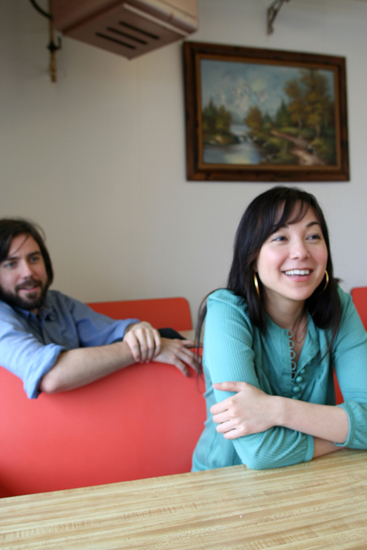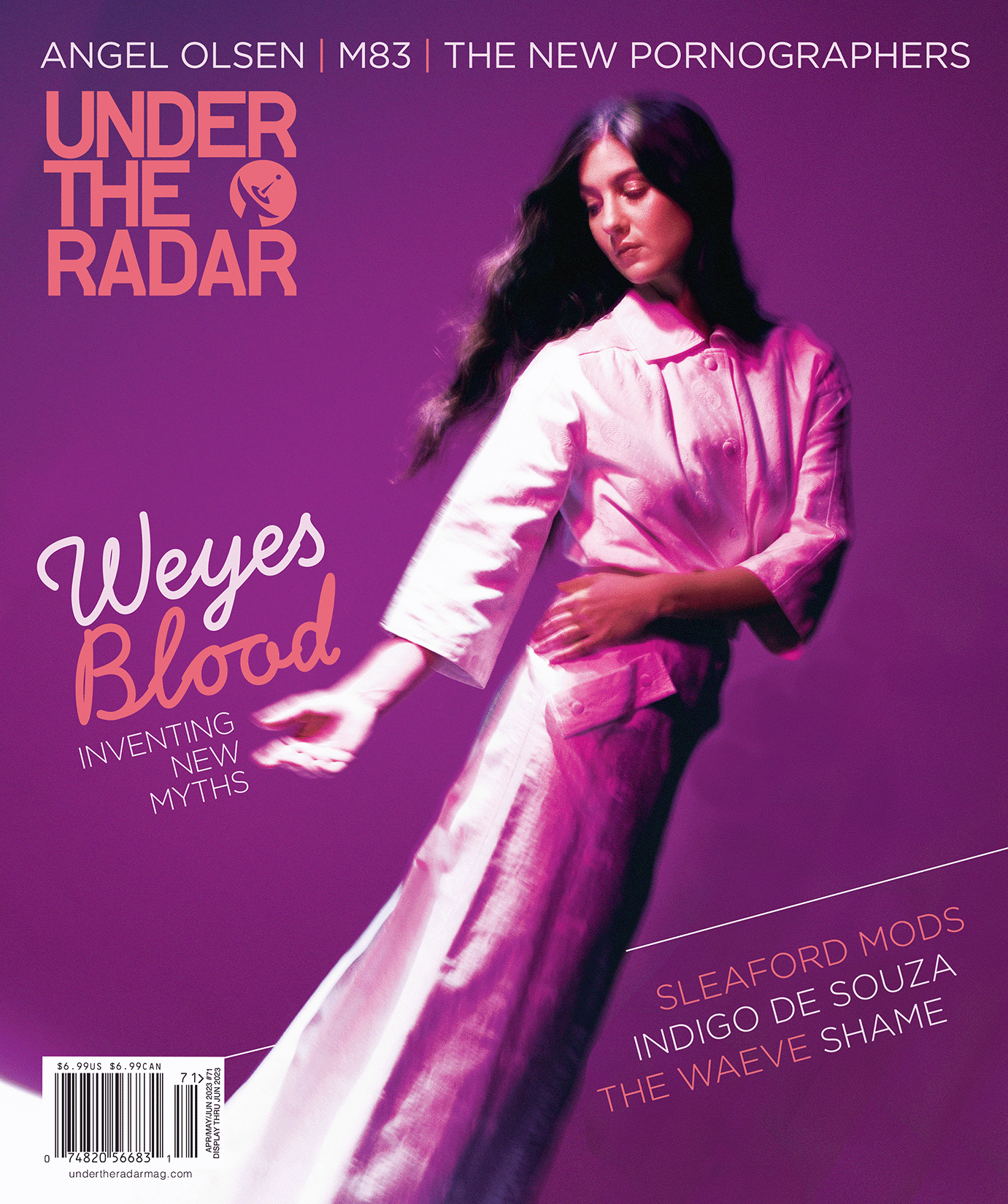
Arthur & Yu
Jul 02, 2007
Arthur & Yu
![]()
The debut of Seattle-based Arthur & Yu, In Camera, is the first album to emerge from the heralded Hardly Art label. But rather than a orgiastic, bombastic showy premiere, Arthur & Yu have made the kind of music that feels as though it’s being played right in your living room…If your living room was around in the late-’60s and was especially suited to wonderfully intertwining male-female vocals. Under the Radar talked to the duo—Grant Olsen and Sonya Westcott—about their appearance on Dntel’s latest album Dumb Luck, their vintage sound, being a label’s first act, and—of course—where apes fit into a live show.
Under the Radar: Your record, In Camera, has a very classic sound. It reminds me of The Mamas and the Papas-era pop music that my mother used to play on our record player—there’s a certain sense of nostalgia. Lee Hazelwood, Velvet Underground, some Leonard Cohen—these all spring to mind to asIn Camera plays in the background here. Where does your sound come from in your memories or your consciousness? Family record collections? Or something else?
Grant Olsen: Sonya’s talked a lot about how her father’s record shelves had a big influence on her. Stuff like Gram Parsons, Emmylou [Harris], Neil Young, etc. Although, I think she played bass in various punk bands for years, so she’s not always been a softy. My folks had those records in the attic as well, but switched them out for Christian bookstore music when I was a kid. So, really, a lot of what I listened to growing up was probably more reactionary to that. Baptist school drop-out music? Probably more nihilistic than what’s going on in this record, to say the least. I kind of found the Lee Hazlewoods and the Donovans on my own. And that sort of stuff is much easier to learn songwriting from than, say, Fugazi or Jesus Lizard. Ha. Not to mention, that style definitely sounds better when playing duet songs in the living room, which is where this record basically comes from.
UTR: It also seems that with the name of the band coming from your childhood nicknames, that sense of nostalgia pops up again.
Sonya Westcott: For me, it started with childhood memories and wanting to be involved with a project that would take me back to hearing certain artists or genres of music for the first time. You know what I mean? Graduating from Disney soundtracks to listening to your dad’s Joni Mitchell records and being really excited and interested.
UTR: How did you replicate that sound—feeling—in the studio?
Olsen: Most of these songs were done at home (with the exception of the third track, which was done in a studio). That doesn’t mean that the bedroom “studio” didn’t get really loud at times. It was rough on my downstairs neighbor, who you can hear banging the roof on one of the songs if you listen closely. Seriously. These songs are also all done on the computer, which is something that I’ve never liked the sound of when I’ve tried in the past, but we got a little mini Mac in our home and it came with some recording software so I started to fuss around with it. I was really just using the computer because I was able to record more tracks on it than I could on my 4-track tape machine. I had bought this tube pre-amp and I replaced the tubes that came in it with older ones so that’s really the only “vintage” material going into the record. So it wasn’t a thing where we didn’t use any instruments made after 1965 or whatever. Hope that doesn’t disappoint people! Really, I mostly spent a lot of time getting the right tone to something before I hit record. I didn’t use a lot of plug-ins, manipulate the sound afterwards, or hit a “vintage” button or anything—mostly because I wouldn’t know how. Basically, I just waited until I got a sound that I liked and kept it there.
UTR: Did you go into the recording process saying, “This is what we want to sound like,” or did it evolve naturally?
Olsen: I think most of the recordings and the songs in general are a product of working against our limitations and constraints. And maybe that’s what it’s about in any art-form. I’m not sure. So maybe this isn’t special in that regard. But this record—probably more than our future records will be—is so much about working with what we had (or didn’t have), because we didn’t have a drum set in the room, or a pianist or flautist around, so there’s a lot of Casio and penny whistle, and hodgepodge percussion on this record. And that probably took a lot longer to put together than if we had professional materials at our disposal, but maybe the process was more fun this way—looking back on it.
UTR: The music deflects some of the attention from the lyrics, which can be pretty dark. I’m thinking of “Afterglow” in particular. How did that tension develop?
Olsen: Nice. Actually, I didn’t realize how dark some of the stuff was until someone else I was playing with pointed it out to me. And it gets worse! There’s this other song that we have that’s not on the record called “Three Horses” and the images for that are taken from this rusty junkheap stable behind the house I lived in as a kid in Phoenix. The horses weren’t taken care of at all. They were in bad shape, and we’d sometimes go over to feed them when we were allowed to. Arizona also has these magnificent hell-bent lightning storms, so you could sometimes hear the horses through the thunder, which, I’d guess, was affecting [them]. And that’s just inherently, or observationally, dark. But the song, like maybe some of the others on the record, is ultimately hopeful and optimistic—at least to me—and really, the song is probably not all that much about the horses when it comes down to it. Ack. This is not a good answer. I don’t know. I don’t think I’m much of a sad-sack, and I believe in playfulness over existential drudgery, but there’s always a bit of a gap between what you think you are and what you really are, I guess. Yeah?
UTR: What’s the writing process like for the two of you?
Olsen: We didn’t do as much collective writing on this record as I hope to do on the second one. But that doesn’t mean that Sonya doesn’t inform a lot of the record. I think, even though some of these songs had been written before we met, they definitely changed after we started to play together. Subject matter, tone, keys, tempo, and that was all worked on together. There are certain subjects that seem selfish to sing about when you’re singing as a duo, and I think the songs that work better are the ones that keep more than just yourself in mind.
UTR: How did it feel to know that Hardly Art wanted you to be the label’s first emissaries out into the world?
Westcott: We were thrilled and extremely flattered but a bit scared as well. Debuting your first album can be nerve wrecking but also being the label’s first band adds to the nervousness.
Olsen: Yeah, terrified! I think we just wanted to do well for them. But everyone over there is so enthusiastic and they’ve become fast friends.
UTR: I recently read an apartment listing that had about a hundred qualifications for the place, one of the warnings being: “This is a very small apartment. NO COUPLES! There is no place to retreat.” I thought it was oddly perceptive for Craigslist, but I think of it now when I think of the two of you on the road, playing shows, recording… How do you find places to retreat from one another? Or is it never necessary—that would be pretty amazing? Please also note I’m not trying to start an argument, merely some kind of physical altercation.
Westcott: I just hide or I don’t answer the phone. I have a special ringtone for Grant so I always know when he’s calling. Totally kidding! I have never really thought about needing to find a place to retreat. We give each other space when we need it, but we’re super good friends and actually enjoy being around each other.
Olsen: Actually Sonya really does have a special ringtone for me. I’ve heard it! It’s probably not always best to give me your number.
UTR: How did you hook up with Dntel?
Westcott: Jimmy is a good friend. He heard some of our early demos and just asked if we would be interested in contributing lyrics/vocals to one of his songs. Of course, we said yes!
UTR: “The Distance” [from Dntel’s Dumb Luck] sounds pretty much nothing like anything on In Camera. Yet you seem so comfortable. Would you like to do something else like it in the future on one of your own albums?
Olsen: Well, honestly, before I got introduced to Dntel I didn’t really listen to much electronic music besides maybe stuff like Björk, Silver Apples, Broadcast, ESG, maybe Tricky? So…stuff that’s not really considered electronic music at all. And we just recently got back from tour with Album Leaf who were so great to watch every night. They had something like five or six Moogs on stage, which looked like a real fun time. Electronic music also looks and sounds like a very expensive fun time. You know? So, I’d say, yes, we’d love to do something else like “The Distance” on one of our future records, but we’re probably too broke at the moment. Ha.
UTR: Have you heard any kind of response from Neil Young for “Come to View (Song for Neil Young)”?
Olsen: No! And that pretty much ended up being the reason for keeping that part in the song title. Well, not really. But, maybe we should’ve lowered the bar. “Song for Bobby Brown?” Maybe could’ve happened.
UTR: What kind of changes can we expect for the live show as opposed to the record?
Olsen: Better instrumentation for starters. I played most of the instruments on the record because no one else was around the house. These guys we have now know what they’re doing and they’re really good, so right away, it’s probably better in that regard. Plus, we have tons of pyrotechnics and lasers in our live show. And apes.
UTR: How did you find your backing band?
Westcott: We tried Craigslist at first, but there are so many great musicians here in Seattle that we lucked out finding the people we did just by asking around and putting the word out through friends.
UTR: And finally, how did you perfect the art of whistling? Was it all done in one take, or did you need stunt lips?
Westcott: Grant has perfected the art of whistling. I can’t whistle to save my life. It’s pretty, pretty sad.
Most Recent
- Weyes Blood Shares New Sci-Fi Video for “Andromeda” (News) — Weyes Blood
- Lifeblood (20th Anniversary Edition) (Review) — Manic Street Preachers
- Zip It Up! The Best of Trouser Press Magazine 1974-1984 (Review) —
- HotWax @ Future Yard, Birkenhead, UK, April 9, 2024 (Review) — HotWax, Trout, Aziya
- Accidentally Preserved: Volume 5 (Review) —


Comments
Submit your comment
November 17th 2010
7:53am
The other way that you can check if a gamertag is to use the gamercard feature on the Xbox. This will allow you to view the profile of other players and provide you with a good deal more information as well.